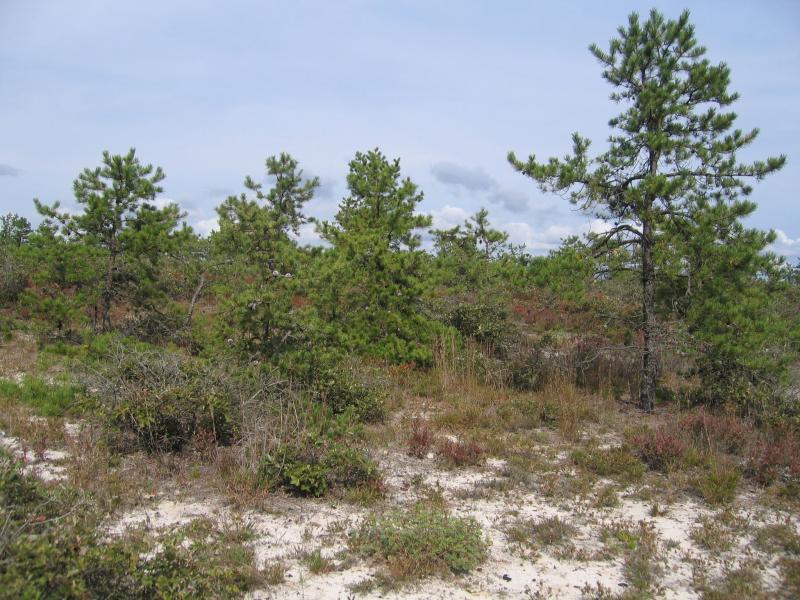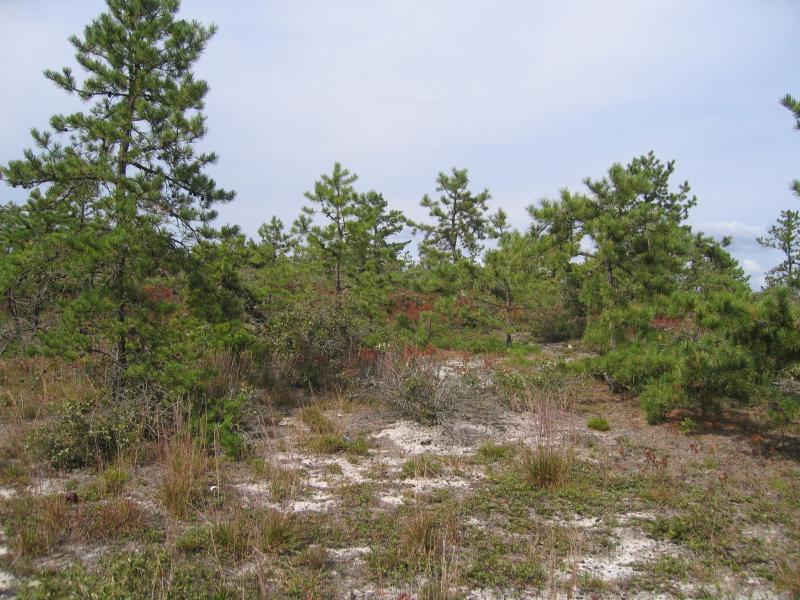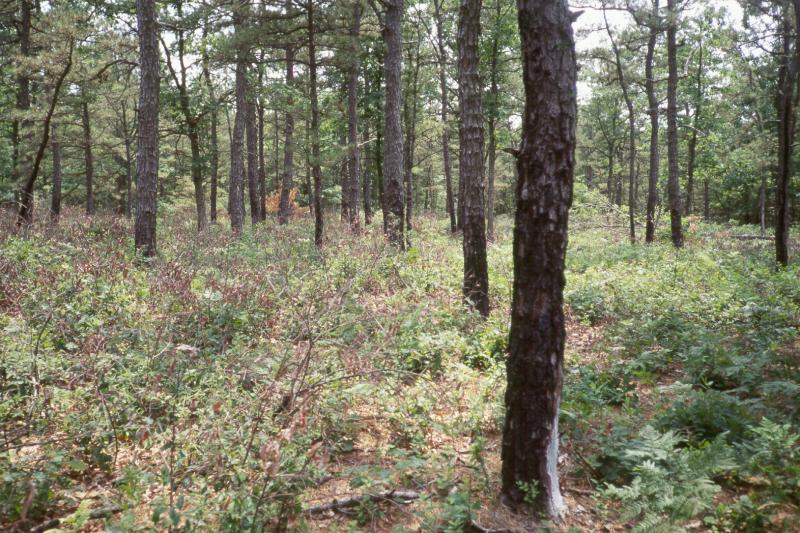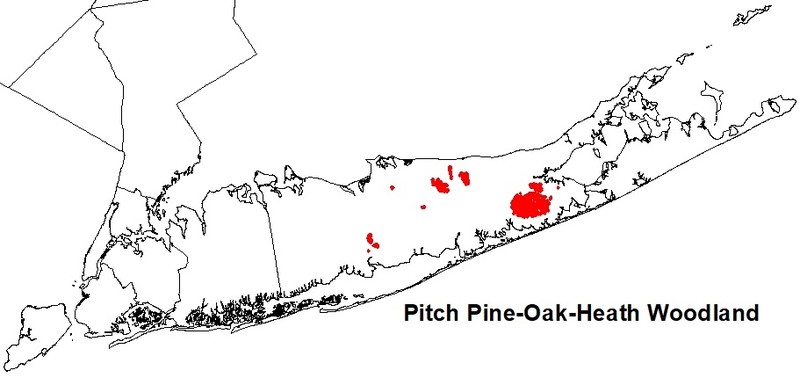Pitch Pine-Oak-Heath Woodland
- System
- Terrestrial
- Subsystem
- Barrens And Woodlands
- State Protection
- Not Listed
Not listed or protected by New York State.
- Federal Protection
- Not Listed
- State Conservation Status Rank
- S2S3
Imperiled or Vulnerable in New York - Very vulnerable, or vulnerable, to disappearing from New York, due to rarity or other factors; typically 6 to 80 populations or locations in New York, few individuals, restricted range, few remaining acres (or miles of stream), and/or recent and widespread declines. More information is needed to assign either S2 or S3.
- Global Conservation Status Rank
- G3G4
Vulnerable globally, or Apparently Secure - At moderate risk of extinction, with relatively few populations or locations in the world, few individuals, and/or restricted range; or uncommon but not rare globally; may be rare in some parts of its range; possibly some cause for long-term concern due to declines or other factors. More information is needed to assign either G3 or G4.
Summary
Did you know?
What are heath species? A heath species is a member of the plant family Ericaceae, which includes the widely familiar blueberry and cranberry species (Vaccinium spp.). Many heath species are well-adapted to thrive under harsh environmental conditions, including excessively dry or wet soils, and low nutrient availability. In addition, some heath species can endure harsh winters and damaging ice. Common heath species of pitch pine-oak-heath woodlands include lowbush blueberry (Vaccinium angustifolium, V. pallidum), black huckleberry (Gaylussacia baccata), and bearberry (Arctostaphylos uva-ursi).
State Ranking Justification
There are less than a hundred occurrences statewide. A few documented occurrences have good viability and very few are protected on public land or private conservation land. This community has a restricted statewide distribution (correlated to pine barrens and sandy soils). Most examples are moderate in size and a few are high quality. Several pitch pine-oak-heath woodlands are threatened by fire suppression.
Short-term Trends
The number and acreage of pitch pine-oak-heath woodlands in New York have probably declined slightly in recent decades due to fire suppression, disturbance by off-road vehicles, trash dumping, and development.
Long-term Trends
The number and acreage of pitch pine-oak-heath woodlands in New York have probably declined substantially from historical numbers due to fire suppression, fragmentation, disturbance by off-road vehicles, trash dumping, and development.
Conservation and Management
Threats
As a fire-dependent natural community, the primary threat to pitch pine-oak-heath woodlands is the suppression of fire. Other threats to this community include development (e.g., residential and commercial development, roads), recreational overuse (e.g., ATVs, hiking trails) and habitat alteration (e.g., excessive logging, construction of utility ROWs). A few examples of pitch pine-oak-heath woodland are threatened by invasive species, such as Japanese barberry (Berberis thunbergii) and black locust (Robinia pseudoacacia). Southern pine beetle (Dendroctonus frontalis) is a bark beetle that infests pine trees, such as pitch pine, white pine, and red pine. Southern pine beetle is native to the southeastern United States, but its range has spread up the east coast to Long Island, New York in 2014. Natural communities dominated or co-dominated by pines would likely be most impacted by southern pine beetle invasion.
Conservation Strategies and Management Practices
Develop and implement prescribed burn plans at appropriate sites. Reduce or minimize fragmenting features, such as roads, abandoned clearings, unnecessary trails, etc. Restrict mountain bikes and ATVs to designated trails and least sensitive areas, and prevent dumping of trash.
Development and Mitigation Considerations
Soils are very thin within this community, and the effect of clearing and construction on soil retention and erosion must be considered during any development activities. These soils are also acidic and nutrient-poor, and any soil enrichment contamination (e.g., from septic leach fields or fertilized lawns) can alter community structure and function. The open structure of this community is maintained by fire and presents a fire hazard to existing and proposed development. Unprotected structures located within or near this community are more susceptible to damage from fire.
Inventory Needs
Continue searching for large sites in good condition (A- to AB-ranked).
Research Needs
Research the composition of pitch pine-oak-heath woodlands on Long Island in order to characterize variations. Determine the optimal fire regime for this community. Further research is needed on the role that frost pockets play in maintaining this community.
Rare Species
- Acronicta albarufa (Barrens Dagger Moth) (guide)
- Agalinis decemloba (Sandplain Agalinis) (guide)
- Ambystoma tigrinum (Tiger Salamander) (guide)
- Amelanchier nantucketensis (Nantucket Juneberry) (guide)
- Anisota stigma (Spiny Oakworm Moth) (guide)
- Apamea burgessi (Burgess's Apamea) (guide)
- Atrytonopsis hianna (Dusted Skipper) (guide)
- Callophrys irus (Frosted Elfin) (guide)
- Carex cumulata (Clustered Sedge) (guide)
- Carex polymorpha (Variable Sedge) (guide)
- Catocala herodias gerhardi (Herodias or Pine Barrens Underwing) (guide)
- Catocala jair ssp. 2 (Jersey Jair Underwing) (guide)
- Chaetaglaea cerata (Waxed Sallow) (guide)
- Cisthene packardii (Packard's Lichen Moth) (guide)
- Crocanthemum dumosum (Bushy Rock Rose) (guide)
- Cyperus schweinitzii (Schweinitz's Flat Sedge) (guide)
- Desmodium ciliare (Hairy Small-leaved Tick Trefoil) (guide)
- Elymus glaucus ssp. glaucus (Blue Wild Rye) (guide)
- Euchlaena madusaria (A Geometrid Moth) (guide)
- Eucoptocnemis fimbriaris (Fringed Dart) (guide)
- Euxoa violaris (Violet Dart) (guide)
- Hemileuca maia maia (Inland Barrens Buckmoth) (guide)
- Hemileuca maia ssp. 5 (Coastal Barrens Buckmoth) (guide)
- Lespedeza stuevei (Stuve's Bush Clover) (guide)
- Lithospermum canescens (Hoary Puccoon) (guide)
- Mononeuria glabra (Appalachian Sandwort) (guide)
- Morrisonia mucens (Gray Woodgrain) (guide)
- Myotis septentrionalis (Northern Long-eared Bat) (guide)
- Psectraglaea carnosa (Pink Sallow) (guide)
- Ranunculus micranthus (Small-flowered Buttercup) (guide)
- Satyrium edwardsii (Edwards' Hairstreak) (guide)
- Schinia spinosae (Spinose Flower Moth) (guide)
- Schinia tuberculum (Golden Aster Flower Moth) (guide)
- Silene caroliniana ssp. pensylvanica (Wild Pink) (guide)
- Speranza exonerata (Barrens Itame) (guide)
- Sphinx gordius (Gordian Sphinx) (guide)
- Viola primulifolia (Primrose-leaf Violet) (guide)
- Zale lunifera (Pine Barrens Zale) (guide)
Range
New York State Distribution
This community is apparently restricted to the Long Island Lowland and Moraine subsection of the Mid-Atlantic Coastal Plain.
Global Distribution
Occurs in the coastal areas of Massachusetts, Connecticut, Rhode Island, New York, and New Jersey.
Best Places to See
- Connetquot River State Park Preserve (Suffolk County)
- Brookhaven State Park (Suffolk County)
- Mongaup Valley Wildlife Management Area (Orange County)
Identification Comments
General Description
A pine barrens community that occurs on well-drained sandy soils in eastern Long Island (and possibly on sandy or rocky soils in upstate New York). The structure of this community is intermediate between a shrub-savanna and a woodland. This community is adapted to periodic fires; the fire frequency has not been documented, but it probably burns less frequently than pitch pine-scrub oak barrens (i.e., more than 15 years between fires).
Characters Most Useful for Identification
A pine barrens community with a shrub layer dominated by scrub oaks, which often form dense thickets. These scrub oak thickets comprise 40 to 70% of the community. Pitch pine (Pinus rigida) and white oak (Quercus alba) are the most abundant trees, forming a canopy with 30 to 60% cover. The shrub layer is dominated by scrub oaks (Quercus ilicifolia, Q. prinoides), and includes a few heath shrubs. Plants occupying the woodland floor include bearberry (Arctostaphylos uva-ursi), heathers (Hudsonia ericoides, H. tomentosa), and Pennsylvania sedge (Carex pensylvanica).
Elevation Range
Known examples of this community have been found at elevations between 20 feet and 1,369 feet.
Best Time to See
The heather species and bearberry come into bloom in early summer, and later, the lowbush blueberry species come into fruit, providing a tasty snack.
Pitch Pine-Oak-Heath Woodland Images
Classification
International Vegetation Classification Associations
This New York natural community encompasses all or part of the concept of the following International Vegetation Classification (IVC) natural community associations. These are often described at finer resolution than New York's natural communities. The IVC is developed and maintained by NatureServe.
- Pitch Pine - (Shortleaf Pine) - Post Oak / (Blackjack Oak, Bear Oak) Woodland (CEGL006383)
NatureServe Ecological Systems
This New York natural community falls into the following ecological system(s). Ecological systems are often described at a coarser resolution than New York's natural communities and tend to represent clusters of associations found in similar environments. The ecological systems project is developed and maintained by NatureServe.
- Northern Atlantic Coastal Plain Pitch Pine Barrens (CES203.269)
Characteristic Species
-
Trees > 5m
- Pinus rigida (pitch pine)
- Quercus coccinea (scarlet oak)
- Quercus velutina (black oak)
-
Shrubs 2 - 5m
- Quercus alba (white oak)
- Quercus ilicifolia (scrub oak, bear oak)
- Quercus prinoides (dwarf chestnut oak)
-
Shrubs < 2m
- Arctostaphylos uva-ursi (bearberry)
- Comptonia peregrina (sweet-fern)
- Gaylussacia baccata (black huckleberry)
- Hudsonia ericoides (golden-heather)
- Hudsonia tomentosa (beach-heather)
- Vaccinium angustifolium (common lowbush blueberry)
- Vaccinium pallidum (hillside blueberry)
-
Herbs
- Carex pensylvanica (Pennsylvania sedge)
- Lechea mucronata (hairy pinweed)
- Pteridium aquilinum ssp. latiusculum (eastern bracken fern)
Similar Ecological Communities
- Pitch pine-heath barrens
(guide)
Pitch pine-heath barrens is a shrub-savanna community that has a very open canopy and an extensive shrub layer dominated by heath species and sweet fern (Comptonia peregrina). It can have a more open canopy than pitch pine-oak-heath woodlands, and often has a more diverse species composition.
- Pitch pine-oak forest
(guide)
Pitch pine-oak forests are mature closed-canopy forest communities. Conversely pitch pine-oak-heath woodland communities have a vegetation structure that is intermediate between a woodland and a shrub-savanna, with a canopy cover that does not excede 60%.
- Pitch pine-oak-heath rocky summit
(guide)
Pitch pine-oak-heath rocky summits occur inland on rocky soils, often on rocky outcrops on summits, ridges, and slopes. Pitch pine-oak-heath woodlands, in contrast, occur on well-drained sandy soils in the pine barrens regions of the coastal plain.
- Pitch pine-scrub oak barrens
(guide)
Pitch pine-scrub oak barrens is a shrub-savanna community that has a very open canopy and an extensive shrub layer dominated by scrub oaks and sweet fern. Within the shrub thicket, there are openings that are dominated by grasses, such as big bluestem (Andropogon gerardii), and Indian grass (Sorghastrum nutans). Pitch pine-oak-heath woodlands can have a more extensive canopy than pitch pine-scrub oak barrens, and they have a lower species diversity and lack the grass-dominated openings.
Vegetation
Percent cover
This figure helps visualize the structure and "look" or "feel" of a typical Pitch Pine-Oak-Heath Woodland. Each bar represents the amount of "coverage" for all the species growing at that height. Because layers overlap (shrubs may grow under trees, for example), the shaded regions can add up to more than 100%.
Additional Resources
References
Edinger, G. J., D. J. Evans, S. Gebauer, T. G. Howard, D. M. Hunt, and A. M. Olivero (editors). 2014. Ecological Communities of New York State. Second Edition. A revised and expanded edition of Carol Reschke’s Ecological Communities of New York State. New York Natural Heritage Program, New York State Department of Environmental Conservation, Albany, NY. https://www.nynhp.org/ecological-communities/
Edinger, Gregory J., D.J. Evans, Shane Gebauer, Timothy G. Howard, David M. Hunt, and Adele M. Olivero (editors). 2002. Ecological Communities of New York State. Second Edition. A revised and expanded edition of Carol Reschke's Ecological Communities of New York State. (Draft for review). New York Natural Heritage Program, New York State Department of Environmental Conservation. Albany, NY. 136 pp.
New York Natural Heritage Program. 2024. New York Natural Heritage Program Databases. Albany, NY.
Olsvig, L.S. 1979. Pattern and diversity analysis of the irradiated oak-pine forest, Brookhaven, New York. Vegetatio 40(2):65-78.
Olsvig, L.S. 1980. A comparative study of northeastern Pine Barrens vegetation. Ph.D. dissertation, Cornell University, Ithaca, NY. 479 pp.
Olsvig, L.S., J.F. Cryan and R.H. Whittaker. 1979. Vegetational gradients of the pine plains and barrens of Long Island, New York. In: Forman, R.T.T. ed. 1979. Pine Barrens: Ecosystems and Landscape.
Reiners, W.A. 1967. Relationships between vegetational strata in the pine barrens of central Long Island, New York. Bulletin Torrey Botanical Club 94(2): 87-99.
Reschke, Carol. 1990. Ecological communities of New York State. New York Natural Heritage Program, New York State Department of Environmental Conservation. Latham, NY. 96 pp. plus xi.
Seischab, F.K. and J.M. Bernard. 1994. Pitch pine (Pinus rigida Mill.) communities on Long Island, New York. Unpublished article. Department of Biology, Rochester Institute of Technology, Rochester, NY and Department of Biology, Ithaca College, Ithaca, NY.
Links
About This Guide
This guide was authored by: Shelley L. Cooke
Information for this guide was last updated on: December 13, 2023
Please cite this page as:
New York Natural Heritage Program. 2024.
Online Conservation Guide for
Pitch pine-oak-heath woodland.
Available from: https://guides.nynhp.org/pitch-pine-oak-heath-woodland/.
Accessed July 26, 2024.



